|
|
|
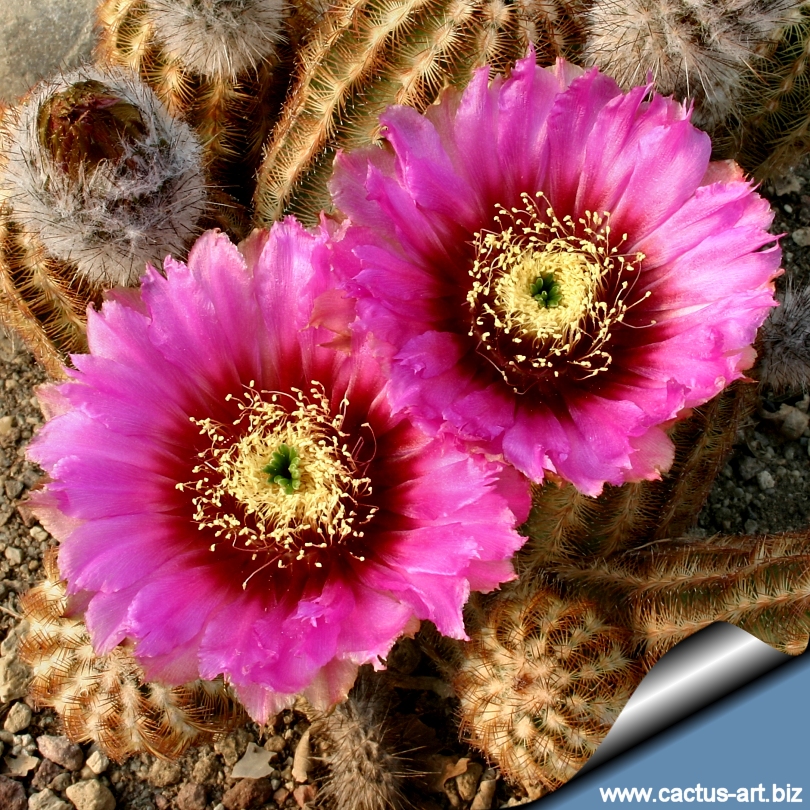
Flowers are
gigantic
intense hot pink-purple, abundant and scented, 5-7 cm long.
|
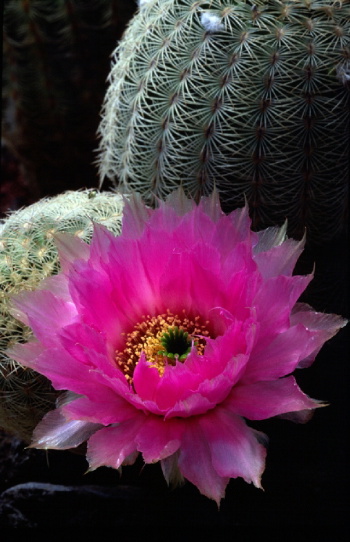
Photo and ©
copyright by
Irwin Lightstone |
Description: Solitary or slowly branching cylindrical shaped cactus
with up to 12 branches. It is one of the smaller Echinocereus species.
Stem: Erect, cylindrical or short cylindrical, 7 to 40 cm tall,
2,5 to 10 cm in diameter
Ribs: 10-19 straight or slightly undulate.
Areoles:1-6(-10) mm apart.
Radial spines: 20 to 36 , straight to slightly curved, held
closely against the the ribs of the stems, organized in 2 series,
pectinately arranged or nearly so, 5 to 8 mm long. Multi-coloured, white
to tan, dull pink, dark brown, or purplish black.
Central spines: 0 to7 ( but usually absent) small , terete,
1-6(-15) mm long, often darker yellowish with a brown tip, at first,
whitish on older areoles.
Flowers: Beautiful, abundant, scented, intense pink flowers, 5 to
7 cm long (5-7 cm). Flower tube 22-40 × 10-30 mm; flower tube hairs 5-15
mm; inner tepals silvery pink to magenta, usually white, crimson, green,
or multicoloured proximally, 23-40 × 5-15 mm, tips relatively thin,
delicate; anthers yellow; nectar chamber 2-5 mm.
Blooming season: Early May to Late June.
Fruit: Ovoid green, olive green, or dark green, fruit up to 28 mm
long; fruiting 1.5-2.5 months after flowering.
Seeds: Black.
|
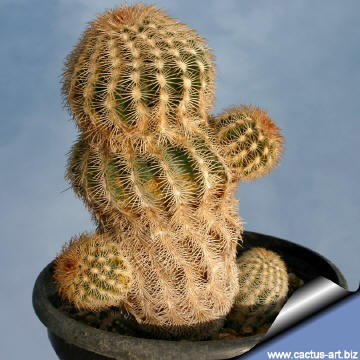 |
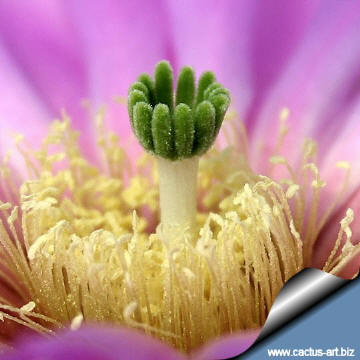 |
|
Echinocereus reichenbachii is cold-hardy and endures frost as long as it
is kept dry. |
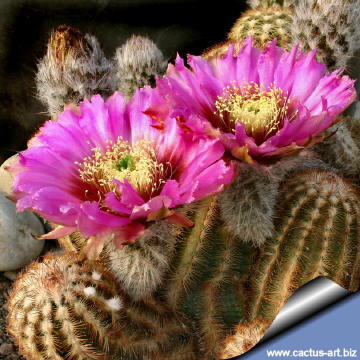 |
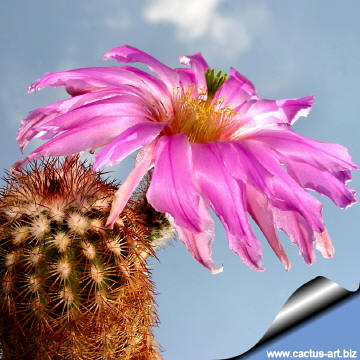 |
|
. |
 |
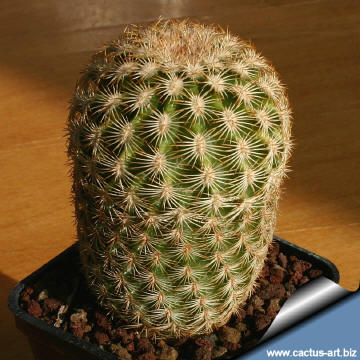 |
|
Advertising
|
|
|
|
|
Family:
Cactaceae (Cactus
Family)
Scientific name:
Echinocereus
reichenbachii ssp. reichenbachii
(Terscheck ex Walpers) Haage Jr. ex
Britton & Rose
Pubblished in: Cactaceae. 3: 25. 1922.
Origin:
Southwestern USA (Colorado,
Kansas, New Mexico, Oklahoma, Texas), northeastern Mexico (Coahuila,Nuevo
León, Tamaulipas)
Habitat:
Chihuahuan Desert, desert scrub,
grasslands, oak-juniper woodlands at an altitude of 0-1500 m; It thrives
in a variety of sites and soils often found growing out of cracks in
solid rock.
Conservation status: Listed in
CITES appendix 2.
Common English Names include: The
popular name of Echinocereus
reichenbachii is Lace
hedgehog cactus or simply Lace Cactus (due to the look of the spines).
Other names are: Black Lace Cactus, Classen's Cactus, Merry Widow
Cactus, Purple Candle Cactus.
Etymology: Named after Mrs. Reichenbach.
Synonyms:
- Echinocactus
reichenbachii Walpers, Repert. Bot. Syst. 2: 320. 1843
- E.
reichenbachii var. albispinus
(Lahman) L. D. Benson
- E.
reichenbachii subsp. baileyi
(Rose) N. P. Taylor
- E. reichenbachii
subsp. caespitosus (Engelmann) W. Blum & Mich. Lange
- E.
reichenbachii subsp. fitchii
(Britton & Rose) L. D. Benson
- Echinocereus
pectinatus var. reichenbachii (Terscheck ex Walpers)
Werdermann 1930
- Echinocereus
caespitosus var. reichenbachii Ters. ex Borg 1937a
The taxonomic and
geographic boundaries among the segregate species or numerous proposed
infraspecific taxa of Echinocereus reichenbachii remain
nebulous and controversial. In no place do pure populations exist
sympatrically, and all taxa appear completely interfertile. Typical
E. reichenbachii is endemic to Mexico, near Saltillo,
Coahuila. The common plants of E. reichenbachii in Texas,
usually lacking central spines, are weakly distinguished from typical
E. reichenbachii and are the basis for E. reichenbachii
subsp. caespitosus. Oklahoma populations with unusually long
bristlelike spines were named E. baileyi Rose [E.
reichenbachii subsp. baileyi]. They intergrade, however,
with the nearby, short-spined populations of E. reichenbachii.
Echinocereus reichenbachii var. albispinus pertains to
intermediates between E. baileyi and E.
reichenbachii subsp. caespitosus. The flowers of E.
reichenbachii var. fitchii are among the largest in the
species, and their exact color pattern may prove taxonomically
significant. Echinocereus reichenbachii var. albertii
is somewhat morphologically and geographically intermediate between var.
caespitosus and var. fitchii, but with
flowers more closely resembling var. fitchii; it is
sometimes considered a synonym of var. fitchii or a
variety of E. fitchii Britton & Rose. The name "Echinocereus
melanocentrus" appears frequently in cactus literature but has
not been validly published.
|
|
The
Echinocereus reichenbachii species group (E. reichenbachii,
E. chisosensis, E. rigidissimus, E.
pseudopectinatus, and a number of Mexican species) has unusually
thin, bristlelike spines clothing the flowers and fruits as well as
conspicuous, cobwebby tomentum of unusually long areolar hairs. The
persistent, dry, white features of the flower tube are an essential
distinction contrasting with the otherwise similar E. pectinatus
species group (E. pectinatus, E. dasyacanthus, and possibly E.
bonkerae), regardless of the spectacular, colorful floral displays.
|
|
|
|
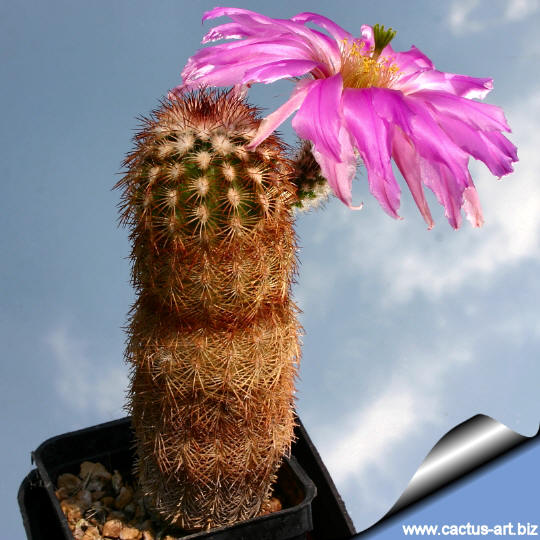
This species has nice green stigma and many
many cream stamens.
Cultivation: It is
sensitive to overwatering (rot prone) needs a very good drainage to
avoid rotting, but requires more moisture than true desert cacti
to grow and produce flowers, Keep drier and cool in
winter. Need full sun. It is very cold resistant from -10° to -25° C (depending on clones) or less for short
periods of time. It is a fine plant for a rock garden or
container, contrasts well with agaves, yuccas, and low-growing flowering
plants.
Propagation: Seeds, also can be grown from cutting as it slowly
branches from the base.
|
|
Photo of conspecific
taxa, varieties, forms and
cultivars taxa
of
plants belonging to the
Echinocereus reichenbachii
complex
(This
Taxon
has lots of synonyms whit several controversial varieties and subspecies):

 |
|